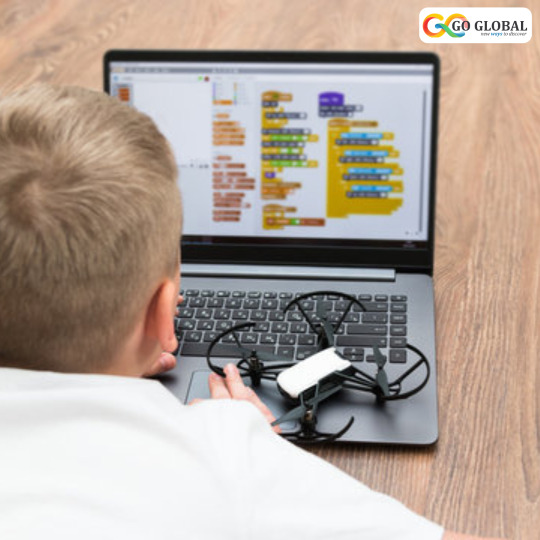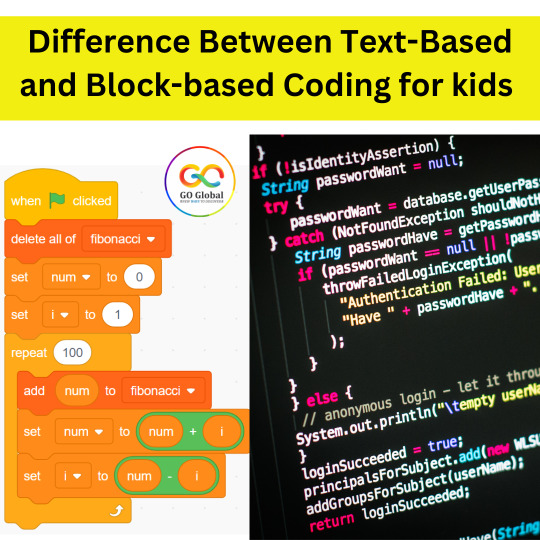#BlockBasedCoding
Explore tagged Tumblr posts
Text
Benefits Block Based Programming For Kids

Accessibility: Block-based programming languages, such as Scratch and Blockly, employ visual blocks instead of intricate code, making it easier and less frightening for newcomers to learn programming.
Engagement: Vibrant, drag-and-drop building blocks and interactive characters or animations draw children in and hold their interest, encouraging a lifelong interest in coding.
Logical Thinking: Block-based programming promotes logical thought and problem-solving as children put together a series of blocks to produce workable programmes.
Creativity: In order to give children a creative outlet inside a regulated learning environment, it allows them to develop and code their own games, animations, and tales. This fosters creativity.
Instant Feedback: Getting immediate feedback after a programme has run helps children comprehend cause-and-effect relationships, which helps them fix bugs and improve their code.
Collaboration: Block-based platforms frequently support sharing and remixing initiatives, fostering cooperation and the dissemination of original ideas across a worldwide community.
Block-based programming for kids offers an accessible way to learn coding. It promotes problem-solving, creativity, and critical thinking. Its visual nature reduces frustration and fosters engagement, providing a strong foundation for future tech-related skills and careers.
#CodingForKids#STEMEducation#BlockBasedCoding#KidCoders#LearningToCode#STEMSkills#CodingBenefits#DigitalLiteracy#FutureProgrammers
0 notes
Text
Block-Based Coding For Kids
Block-based coding or Coding programs use a drag-and-drop learning environment, where coders use coding instruction “blocks” to construct animated stories and games and bring their creativity into reality. With block based coding programs, kids can let their imaginations run wild, creating any number of sprites(image, character, or object), and bringing those creations to life with animation. Isn't this sound interesting to you? For students ready to jump into block-based coding programs right now, they can do so with a 1:1 instructor in our online coding courses on the GoGlobalways.com platform.
Read more- https://goglobalways.com/blog/how-block-based-coding-helping-kids/

#blockbasedcoding#codingforkids#coding#codingcourses#blockbasedprogramming#benefitsofblockbasedcoding#benefitsofblockbasedcourses#learnblockbasedcoding#blockbasedcodingforkids
0 notes
Photo

Everybody at my school has a CODE.org account and program (block-based). This year I rolled it out for my kindergarteners. It was difficult at first, but once they got the hang of it, it was somewhat smooth sailing with minor occasional glitches here and there.
#CodeOrg#Coding#Programming#Makerspace#LosRoblesRonaldMcNairAcademy#Kindergarten#RavenswoodsCitySchoolDistrict#BlockBasedCoding
0 notes
Text
Difference Between Text-Based and Block-based Coding for kids

Languages like Python or JavaScript. Complex syntax, punctuation, and spelling must be understood. Beginners might find this difficult, but once mastered, it allows for greater creativity and control.On the other hand, visual blocks with labels and icons are used in block-based coding. Here same difference between Text-based and Block based Coding for Kids. Children may write code by dragging and dropping these blocks, which makes understanding coding ideas easier. The learning curve is kinder, and feedback is given right away. While text-based coding may offer a more controlled environment for beginners, creativity may be constrained in some ways. As students must adjust to new syntax, the shift to text-based coding can be difficult. Before moving on to more complex programming, students can learn the basics of coding by using block-based coding as an introduction. The decision between the two is based on the child's age, level of curiosity, and readiness to work with complex coding.
0 notes
Text
What is Block-Based Coding for kids?

Block-based coding is a simple way of coding that is designed to introduce children to coding concepts in a visual and easy way. This programming language is also called drag-and-drop programming because you code to create programs You can drag and drop the block. Beginners love this kind of code since it's so simple to grasp and apply.
You may also create stories, games, and animated videos using block-based code. It was created by MIT scientists to make learning to code accessible to everybody, and it's an excellent approach to introducing children to computer science. Block-based coding is an easy way for kids to learn coding through play. Children will continue to improve their coding skills with entertainment so that they will be able to improve their future. It is necessary to have more time to learn block-based coding.
0 notes
Text
What Are Some Examples of Block-Based Coding Languages?
Block-based coding languages are programming languages that use visual blocks to represent code constructs and enable users to create programs by arranging and connecting these blocks. Here are some popular examples of block-based coding languages:

Block-based coding languages are programming languages that use visual blocks to represent code constructs and enable users to create programs by arranging and connecting these blocks. Here are some popular examples of block-based coding languages:
Scratch: Scratch is one of the most well-known block-based coding languages developed by MIT. It is designed for beginners and children to learn programming concepts by dragging and dropping blocks to create interactive stories, animations, and games.
Blockly: Blockly is a library developed by Google that provides a framework for creating block-based coding languages. It is used by various platforms, such as Scratch, App Inventor, and Code.org, to create block-based coding environments.
BlocklyProp: BlocklyProp is a variant of Blockly specifically designed for programming Parallax microcontrollers like the BASIC Stamp and the Propeller chip. It simplifies the process of writing code for robotics and electronics projects.
App Inventor: App Inventor is a block-based programming language developed by MIT that allows users to create mobile apps for Android devices. It provides a visual interface for building apps by connecting blocks that represent app functions and components.
Snap: Block-based programming language Snap! was created at UC Berkeley. It is a compiler for computer languages that enables you to create graphical pictures by dragging and dropping Blocks.
Discord Coding Block: Discord does not require users to know how to code in order to send messages, but it does allow users to code their messages in order to stand out from the crowd. Users have the option to transmit texts with format modifications, like changing the background color.
These are just a few examples of block-based coding languages, but there are many more available, each with its own unique features and target audience.
#BlockBasedCoding#CodingForKids#ScratchProgramming#AppInventor#CodingEducation#LearnToCode#VisualCoding
0 notes
Text
Benefits Block Based Programming For Kids

Kids can learn how to code easily by using block-based programming. The visual, drag-and-drop interface it uses removes grammatical complications so that young learners can concentrate on reasoning and problem-solving. Immediate feedback increases engagement by assisting students in understanding cause-and-effect linkages. Early computational thinking development is encouraged by the strategy, which also promotes creativity and logical thinking. The switch to text-based coding becomes easier as one's skills advance, and knowledge of fundamental principles of programming remains useful. Collaborative elements also promote cooperation and communication. Block-based programming gives kids an approachable and entertaining introduction to coding while fostering their confidence and love for technology and innovation. This gives kids the skills they need for the digital age.
0 notes
Text

Regular programming is a distant relative of block-based programming. It makes use of "blocks" of code that may be dropped on a workspace and put together to create logical and useful programs. Due to the lack of tiresome typing or the need to memorize programming grammar, it is especially suitable for kids. Every programming "block" (often referred to as the building blocks of programming like conditionals, loops, variable declarations, and function calls) is symbolized by a little piece of a "block" that resembles the pieces of a jigsaw puzzle.
To create the final code, the user must drag & drop these components into a workspace and then connect them. Due to the absence of typing, this approach significantly cuts down on coding time. These jigsaw puzzles "pieces" or "blocks" are connected to create every line of code. Hopefully, it is now evident what block coding is after reading this explanation.
Block-based coding for kids is not only quick and easy for youngsters, but it's also a lot of fun. It's awesome that kids can create practical projects using interactive building blocks while learning how to code. Block-based coding fosters in children a sense of curiosity that aids in their development as lifelong learners. It aids in their problem-solving growth, which will further their character development. The students doing the graphical programming course will run across a lot of situations where they will need to assess the circumstances and determine the best course of action. They will achieve new heights in the fields of their choice by applying the same strategy in life. As a parent or student, do not be afraid of block-based coding.
0 notes
Text

What is kid-friendly block-based coding, you ask? It is a branch of coding that embodies the goal of coding to aid young minds in comprehending the difficulties and basics underlying how computers function. The most fundamental kind of computer programming, block coding for kids, is a terrific place for young people to start. With block coding, kids may utilise visual instruction blocks to build games or move animations without having to write complicated lines of computer code since it uses a straightforward drag-and-drop interface.
The idea that block-based programming is useless for children frequently deceives people. To be clear, this is only a MYTH, we say. Block coding frees children from the pressure of learning complicated grammar and lets them explore the world of code without restrictions. By purely using their imagination, they can produce any number of projects.
In addition to being quick and simple for children, block coding for kids is also a lot of fun. We think it's really cool that students get to utilize interactive building blocks to construct real-world projects while learning how to code. Children also get to co-create projects in our programs. Dr. Nidhi Khurana, the founder, and CEO of GoGlobalWays is adamant that learning is an experience best shared with others. As a result, we incorporate this principle into our lessons and help all of the students enjoy studying.
0 notes
Text
Block-Based Coding Courses For Kids- GoGlobalways.com

Block-based coding is a sub-branch of coding that embodies the purview of coding to help young kids understand the complexities and fundamentals behind the working of computers. It is just as powerful and useful as text-based language, but easier to use and understand.
Interestingly, block-based coding does not require syntax, and the text-based software employed for teaching this automatically converts the commands in the form of boxes. That way, the kids are visually passionate, and they are more interested in understanding the basic concepts of advanced programming language.
Benefits of Block-Based Programming for kids
Block-based coding removes the burden of learning complex syntax and allows kids to explore the coding world without any hurdles.
While learning how to code, kids get to use blocks that they can put together to create real-world projects.
3) Doing projects require them to write long codes, fix bugs, and tweak the results until they’re satisfied and thus developing perseverance in them.
Coding also helps them develop problem-solving skills that they can use in other areas of life.
0 notes